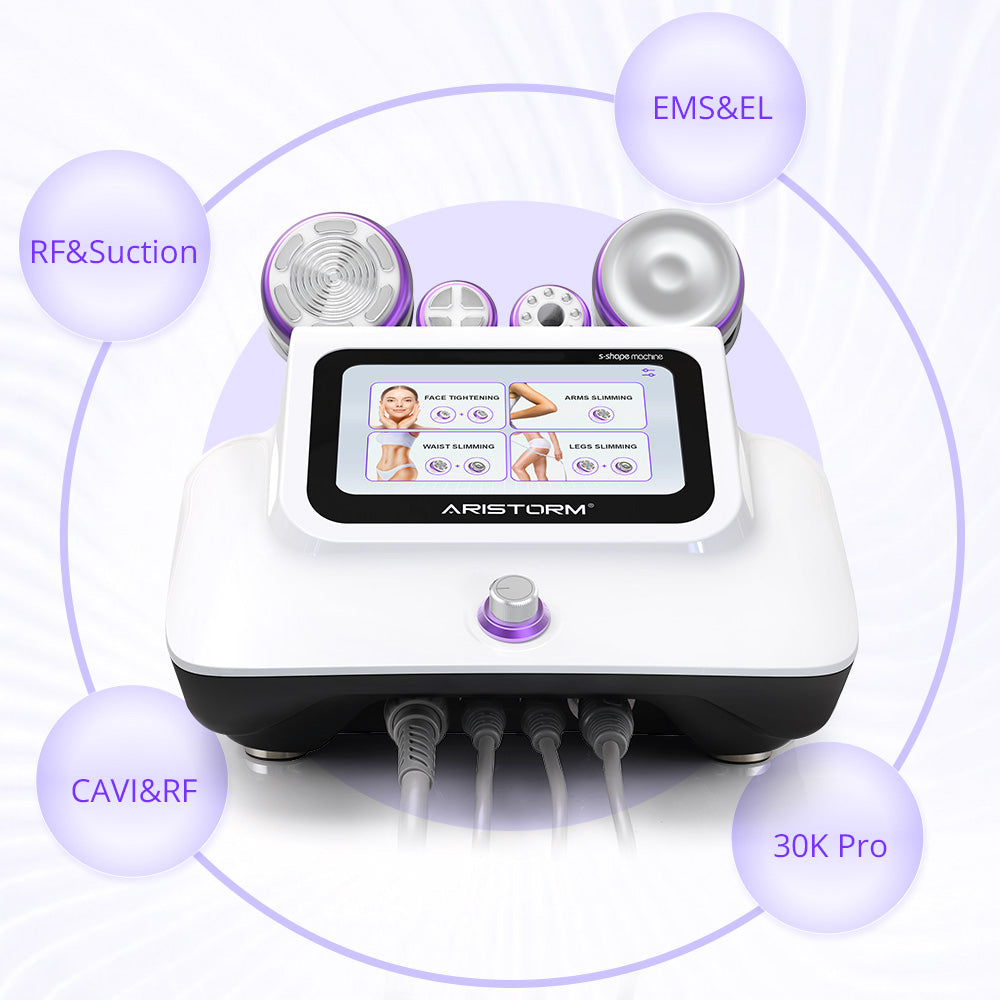How Does Ultrasonic Cavitation Work to Remove Fat?
How Cavitation Works?
Ultrasonic cavitation relies on ultrasound technology to break apart fat cells.
Ultrasound waves are sent deep into the layers of your skin, causing a disruptive vibration. Fat cells then break apart from each other and are dislodged from your dermal layers.
After a few days, the fat cells are absorbed by your lymphatic system and drained as waste from your body.
The Basics of Cavitation
The phenomenon of cavitation occurs when the pressure in the liquid goes below its vapor pressure. This results in the production of vapor or gas cavities or bubbles in the liquid that eventually explode producing localized energetic shockwaves.
Cavitation can be inertial or non-inertial based on the speed of bursting of the produced bubbles during the process.
An important type of cavitation called ultrasonic cavitation refers to the use of ultrasonic vibrations to put pressure on the medium which results in the formation and bursting of bubbles.
Understanding Ultrasonic Waves
You may have already heard about ultrasonic waves but never know exactly what they are and how they function in different dimensions.
To understand them easily, let’s go to the basics about sound waves. They are simply vibrations that have some frequency and can pass through the medium of water, air, and metals. Ultrasonic waves are also acoustic waves or vibrations but have frequencies more than the upper audible range of humans. The upper audible frequency range for humans is typically 20kH or 20,000 hertz (Hz). It means ultrasonic waves are inaudible to the human ear.
The main difference between ultrasonic waves from other waves lies in this vibration frequency as they vibrate at a much higher speed and the word ‘sonic’ also specifically applies to ultrasound waves that have very high amplitude.
Ultrasonic waves have several important properties that make them useful for multiple applications.
- They have high penetrating power because of their shorter wavelength and can move through solids, liquids, and gases easily however they can't move through a vacuum.
- Because of their high energy content, they can be moved over longer distances without much energy loss.
- Within the medium, ultrasonic waves travel with the speed of sound with maximum speed in denser mediums.
- When passing through objects, ultrasonic waves produce intense heat.
- These waves also produce compressions and rarefactions like sound waves.
- Ultrasonic waves even produce vibrations in low-viscosity liquids.
- When precision and accuracy are needed, ultrasonic wave’s frequency range also helps with this.
Mechanism of Ultrasonic Cavitation
How does ultrasound cavitation work? The high-frequency sound waves of above 20,000 hertz or the sonication process rapidly compress and expand the medium as they move through it and cause pressure fluctuations in the medium. The vapor-filled bubbles are produced as a result of this which undergo more development and oscillation when ultrasonic vibrations are in the low-pressure phase and abruptly burst when ultrasonic waves are in the high-pressure phase. This bursting happens because the bubbles reach a certain size and can no longer support their existence. This collapse of cavitation nuclei causes strong shockwaves which can damage the nearby structures or cells in the human body.
Now you may wonder does ultrasonic cavitation works for fat reduction. Yes, it does, and understanding the ultrasonic cavitation process helps you learn this more effectively.
Simply speaking, in this non-invasive ultrasonic cavitation process of body contouring, when an ultrasonic transducer is applied to the fat cells, ultrasonic waves put pressure on the targeted fat cells through the produced and burst cavitation bubbles. This ruptures the fat cells and breaks open the contents within. These contents are eventually removed from the body through the natural elimination process.
Cavitation Bubbles and Their Behavior
In ultrasonic processes, the produced cavitation bubbles because of the acoustic streaming are extremely small in size that you can’t see them with your naked eye. They are only a few millimeters to nanometers.
As already mentioned, they are produced, developed, and collapsed in response to rapid pressure fluctuations in the medium because of ultrasonic waves.
The collapse of these microbubbles is quite abrupt and rapid which increases the temperature and pressure waves of the collapsing bubble. This process of collapse generates energy as localized heat, microjets, and shock waves.
This energy or mechanical force makes the cavitation bubbles and the process of ultrasonic cavitation is useful in several beneficial applications.
What Happens During An Ultrasonic Cavitation Session?
The procedure for ultrasonic cavitation is pretty straightforward.
You should sterilize the area of your treatment using alcohol. Using a handheld ultrasound device, they’ll slowly go over the target area of your body.
You may hear a buzzing from the ultrasound machine. Treatments typically take between 40 minutes to an hour.
Targeted Areas For Ultrasonic Cavitation
Ultrasonic cavitation is also frequently performed on the:
- stomach
- hips
- face
- neck
- upper arms
- thigh areas
What Ultrasonic Cavitation Side Effects?
Ultrasonic cavitation is considered a low-risk treatment for most people. Common side effects include:
- redness
- bruising
- headache
In some cases, the skin won’t absorb the fat evenly after it breaks down. Lumps, bumps, and valleys on your skin can appear after ultrasonic cavitation treatment.
These skin irregularities may be resolved by followup treatments.
What To Expect After Ultrasonic Cavitation
But don’t expect to see results right away. Right after your treatment, your body might feel puffy or swollen. It takes time for your body to break down and dissolve the fat cells that have been dislodged.
You may also require repeated treatments to see visible results. Most candidates for this treatment see their final result within 6 to 12 weeks. On average, treatment requires 1 to 3 times for visible results.
Results of this treatment are permanent, as long as you maintain a healthy diet and exercise. If you have a sedentary lifestyle, fat deposits may return to areas that have been treated.
Before And After?

Applications of Ultrasonic Cavitation
Read on to learn how ultrasonic cavitation functions in different dimensions.
- Ultrasonic cleaning: It is a quite common application of ultrasonic cavitation mechanism that gives high-quality cleaning using the sonication process. The energy produced after the bursting of cavitation bubbles scrub the surface and a liquid agent rinse away the impurities and all loosened matter.
- Sonochemical reactions: Sonochemistry is the research area in which ultrasonic waves are used to enhance or change any chemical reaction. The energy from cavitation bubbles can help in improving processes such as emulsification catalysis and for sonoluminescence.
- Therapeutic applications: A common and significant benefit concerning therapeutic ultrasound is weight reduction. It can be used to reduce adipose tissue and store fat in the body without any surgical procedures. Some other applications can be ultrasonic imaging or ultrasonography, breaking kidney stones, and administrating targeted medication.
This small list of benefits can give you an idea of how vast the applications of ultrasonic cavitation can go from industrial procedures to therapeutic bioeffects.
Safety Considerations and Limitations
Generally, understanding the ultrasonic cavitation process is completely safe for you but there are still a few points that you should keep in mind.
This process involves the collapse of cavitation bubbles, which release a burst of energy too resulting in high temperatures and pressures at the site. In therapeutic applications involving your body, this can cause tissue heating, burns, or damage.
So should you not go for ultrasonic cavitation? No, there are some steps you can take to ensure safety.
Let's see what can you do to reduce any hazards of this sort. Go for protective steps such as cooling mechanisms that apart from the heating, keep the cool there.
Secondly keep in mind that not all materials respond similarly to ultrasonic cavitation with chances of delicate surfaces having some major damage. So when applying ultrasonic cavitation to delicate surfaces or easily damaged materials, practice it with extreme caution by following all the safety regulations. This ensures the maximum chance of getting benefits from ultrasonic cavitation and reduce any possible risks.



Just purchased machine and was wondering whats the difference for A and B mode? Also, the vacuum part really hurts, am I doing something wrong?
Leave a comment